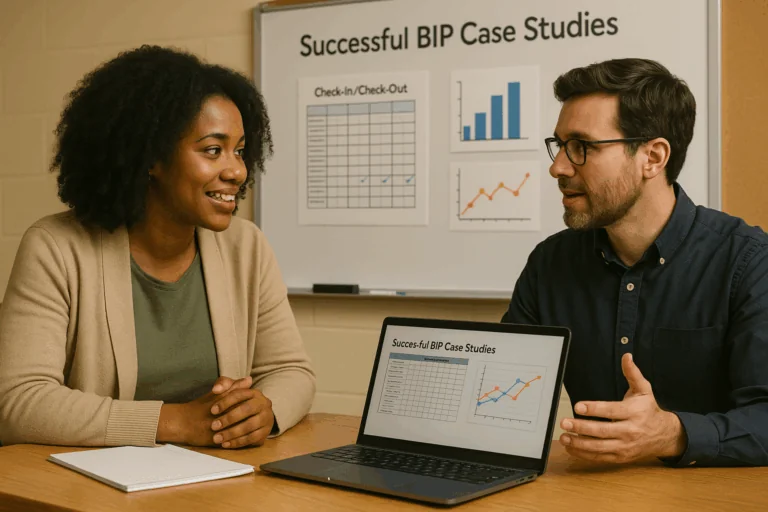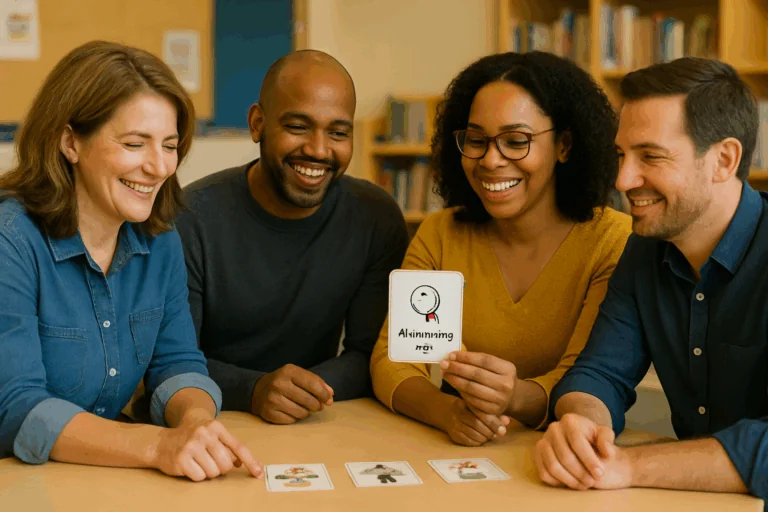When Jessica (Jess) Brown, Assistant Principal at Westside Elementary School in West Fargo, North Dakota, talks about behavior support, she doesn’t start with challenging behavior, complex learners, or data. She starts with relationships.
“With strong relationships come strong behavioral gains.”
That phrase has become a mindset at Westside Elementary. It’s how Jess and head principal, Chris Kalsow, leads their staff and supports their students. By focusing on connection first, Jess and her team have built a system that meets students’ behavioral and social-emotional needs consistently and proactively.
That belief, along with the dedication and vision of her team, led Westside to rethink how it supports students across tiers and, in the process, to create a sustainable, student-centered system.
Identifying the Need: Consistency, Structure, Community
Jess’s foundation in social-emotional learning began early. Before becoming a teacher, she worked at a YMCA afterschool program, where she saw the importance of balancing academic success with social and behavioral growth. That early lesson in the value of teaching social skills and executive functioning has shaped her approach ever since.
Now, as an administrator, she helps her staff build systems that make time for those same essential skills, especially for students who need additional Tier 2 and Tier 3 supports.
Westside Elementary serves about 400 students in grades K–5, including two Structured Learning Community (SLC) classrooms supporting learners with emotional and behavioral disorders (ED). Like many schools, Westside’s team worked to balance proactive teaching with responsive supports. But they noticed that some interventions weren’t happening consistently because staff were responding to multiple student needs at once.
Because adding new staff wasn’t an option, the team looked for creative ways to strengthen existing supports already in place. Holly Walker, one of the Special Education Teachers at Westside, had the original idea to make a big change and from that, they focused on building a sustainable system that ensured every student could access the right level of help when needed. The special education teachers embraced the idea of shared spaces and shared responsibility, leading to a powerful shift in mindset, every adult in the building had a role in supporting behavior.
Before moving deeper into Tier 2 and 3 systems, the staff focused on strengthening their Tier 1 practices and PBIS foundation. A key component of this work was a consistent focus on the schoolwide expectations: Be Safe, Be Respectful, Be Responsible. These expectations were displayed on posters throughout classrooms, hallways, and common areas, with clear examples of what each behavior looked like in different settings. Teachers explicitly taught and retaught these expectations so that every student received the same instruction and reinforcement.
Another Tier 1 strategy implemented consistently was Golden Tickets, which were awarded to entire classes by staff members who observed students demonstrating the schoolwide expectations. This simple system encouraged positive behavior, built excitement among students, and created buy-in from all adults in the building. Establishing these universal supports helped strengthen Westside’s sense of community and laid the foundation for the more intentional structures developed to support students who needed additional help.
Westside has partnered with Behavior Advantage for four years to support this vision. The school’s emphasis on consistency, shared ownership, and a team-based approach to problem-solving aligns closely with Behavior Advantage’s philosophy of clear systems, common language, and aligned practices across every classroom and tier of support.
Building Consistency Through Creativity and Collaboration
Guided by that shared philosophy, Westside established the Wildcat Zone as a flexible support space that reinforces Tier 1 expectations while providing targeted Tier 2 interventions. Students use the space for scheduled supports, de-escalation, and to practice self-regulation and build social-emotional skills through activities such as social-skills instruction, reward breaks, and short resets throughout the day.
To build consistency, the team aligned the Wildcat Zone with existing interventions such as Check-In/Check-Out (CICO), movement breaks, HUG (Hello-Update-Goodbye) sessions, and social-skills groups, all connected to the school’s PBIS framework. Rather than creating individualized plans for every new situation, the staff now follow a systematic approach based on the learner’s function of behavior. When a learner needs movement, attention, or a sensory break, the plan is already in place. Teachers no longer have to guess what to do; they can respond with confidence and consistency.
Using Behavior Advantage to Strengthen Tier 2 Systems
Check-In/Check-Out (CICO) has become one of Westside’s most effective Tier 2 supports – and it’s fully managed through Behavior Advantage.
Each participating student has individualized CICO goals that align with their behavioral function. These goals are developed collaboratively by the MTSS-B team and the student’s teacher, then entered into Behavior Advantage to guide daily support. The classroom teacher serves as the student’s mentor, reinforcing positive behaviors and offering feedback throughout the day while entering data directly into the platform. This makes progress and graphs easy to access and review, whether during team meetings or for quick daily check-ins.
When communication with families is part of the plan, CICO sheets can also be shared home effortlessly, either printed or emailed based on family preference, creating a consistent and transparent process that supports fidelity and connection.
By having a clear structure for data entry and progress tracking, staff can focus less on logistics and more on meaningful interaction with students. Many educators worry that data collection adds another layer to their workload, but Westside’s experience shows the opposite. When teachers understand the purpose behind the process and have tools that make it manageable, they engage fully.
The Behavior Advantage platform supports Westside’s Tier 2 systems by allowing staff to:
- Review CICO data in Behavior Advantage and other Wildcat Zone data during MTSS-B meetings – Grab our free meeting Agenda Template here!
- Monitor student progress to guide next steps
- Align interventions based on the function of behavior
- Plan, track, and fade supports as students gain independence

When the Tier 2 and Tier 3 teams meet, they no longer start from scratch. The data housed in Behavior Advantage gives every team member a clear picture of what’s working, where to adjust, and when to reduce supports. That clarity keeps conversations solution-focused and collaborative.
If you are looking for ways to improve the efficiency of your MTSS-B meetings, make sure to download our Agenda Template!
A Team-Based Approach to Sustainable Support
Teamwork is at the heart of Westside’s success. Rather than relying on one person to manage Tier 2 and 3 supports, the school rotates multiple staff through the room throughout the day. This shared model keeps the Wildcat Zone active and responsive without adding new positions and empowers educators and support staff to consistently support learners and each other.
Clear expectations help every team member, teachers, paraprofessionals, and administrators, make consistent, informed decisions. This structure reflects a key Behavior Advantage principle: strong systems lighten individual workload and build shared ownership. By aligning roles and expectations, Westside transformed a staffing limitation into a model of collaboration, trust, and consistency.
More Than Four Walls
At Westside, the system is more than a physical space. It represents a belief that structure and relationships must work together to shape behavior. The Wildcat Zone provides the framework, but the people bring it to life.
Behavior Advantage mirrors that same philosophy. The platform helps teams put their beliefs into action through clear systems, data visibility, and consistent follow-through. It allows educators to focus on what truly matters – building relationships and helping students grow.
Through collaboration, strong foundational Tier 1 practices, and data-driven reflection, Westside Elementary has created a sustainable, equitable model that supports students proactively. What started as one teacher’s idea has become a system powered by teamwork and shared commitment.
Consistency That Lasts
Westside Elementary’s story reflects how one school’s leadership, teamwork, and clear systems can strengthen support across an entire district. What began as a building-level effort to create consistency and proactive behavior supports has become a model for how schools within a district can align their Tier 1–3 practices. By focusing on relationships, data, and shared ownership, Westside has built a sustainable framework that benefits students and staff alike.
Behavior Advantage plays a quiet but powerful role in that success, giving both school and district teams the tools and visibility to stay aligned. The platform helps maintain consistency across classrooms, support collaboration during MTSS-B meetings, and ensure fidelity as practices scale across schools.
Westside’s approach demonstrates how districtwide impact begins with strong leadership, a unified vision, and systems that empower staff at every level to do their best work.
Districts across the country are building similar capacity – using consistent, data-informed processes that strengthen Tier 2 systems, improve student outcomes, and sustain success year after year.
Ready to strengthen your behavior systems across every Tier? Behavior Advantage helps districts build the consistency, visibility, and team-based structures that make Tier 1–3 supports sustainable and effective.











